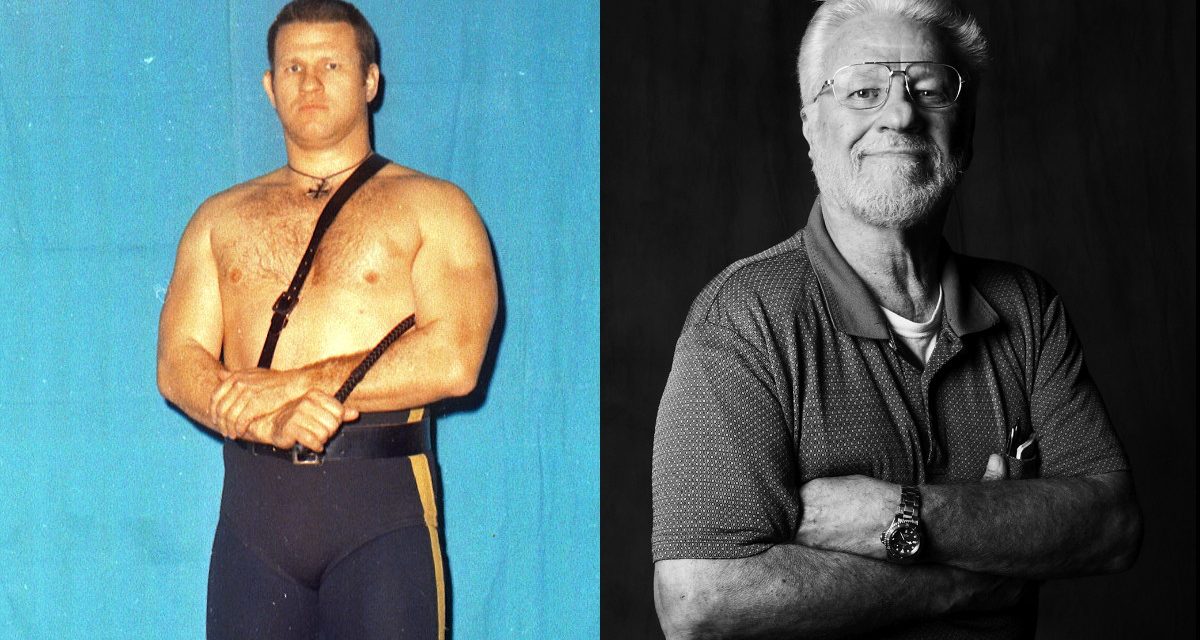As you will read in this question and answer session, made up primarily of questions from the SLAM! Wrestling readers, the great German heel Waldo von Erich has a high opinion of himself — and rightfully so. He was a very big star in the 1960s and ’70s, and rarely gets a chance to tell his side of the story.
From teaming with his “brother” Fritz Von Erich, to his famed curfew battle with Bruno Sammartino at Madison Square Garden, to his time in Australia, and Calgary, Wally Seiber of Toronto takes us through his storied professional wrestling career.
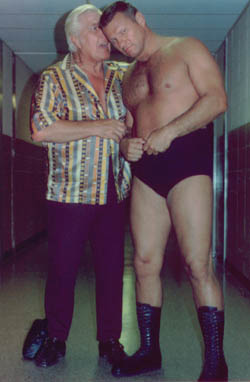
Freddie Blassie gives some advice to Waldo von Erich. Photo by Mike Lano, WReaLano@aol.com
“He could emote such hatred. He had that Nazi snarl, he had stuff down. He could just turn people upside down. He totally had control of his interview. He was a great interview,” recalled Bill Watts.
Well, in this interview (so lengthy — with more than 100 questions — it will run in two parts), he is at times humble, other times boastful, sometimes the details elude him, and in other circumstances, he’s bang on. It was conducted by telephone at the end of January 2009 from his home in Elmira, Ontario.
Enjoy the question and answer session, which is presented in the order asked, but note, unless specifically credited, the remaining questions are by the interviewer, Greg Oliver, who has known von Erich for many years and interviewed him previously.
Q: This is probably an obvious question, but curious where and when he first crossed paths with Fritz von Erich and what history they had before he became Waldo. [Crimson Mask, Florida]
A: I wrestled on my own, as Wally Sieber and Waldo von Sieber. I saw him down in Toronto, and I contacted him. The first time I worked with him was out there in Minneapolis, Minnesota.
Q: That was the first time you were his partner.
A: Yeah.
Q: Did he approach you or did you approach him?
A: I approached him. He saw me wrestling, and I approached him, and we got together when we went out to Minneapolis there. That’s where [we] started to go with it.
Q: Could you please ask Waldo about a promotion in 1957 that toured Ontario. I recently found some clippings that feature him in the Main events in July at the Simcoe Armory. Would they have been either Red Garner’s promotion or was Red partnered up with Dave McKigney at this time. [Wes Maidment, Cambridge, ON]
A: Probably Red Garner.
Q: Was McKigney involved in promoting at the time?
A: No.
Q: That seems awfully early for him, ’57.
A: Yeah. Dave was brought up in what you call an Orange Home. … Up in Maple, I think it’s called the Orange Home. He was raised by it for a while there….
Q: It was like an orphanage?
A: It was a different kind of thing. I forget what they call it. But Knights of Columbus, or something like that. It was up in Maple or wherever.
Q: And you knew of that because you met him down at the gym in Toronto?
A: I met him at the YMCA, I believe it was.
Q: What does Mr. von Erich remember from his time wrestling for Pedro Martinez and the NWF? [Angelo Furlan]
A: A lot of the guys didn’t like him (Martinez) but I liked him, and he liked me, because I made him money. As a matter of fact, he offered me part of the territory, the same as WWF offered me 22%. You know that?
Q: We talked about that last time. What didn’t people like about Pedro as a promoter.
A: Well, everyone always thinks the promoter is screwing them. I had no qualms against him, but Pedro was, I guess he kind of used people, the same as anyone else, as Vince McMahon did. If you are in business, you can’t do everything that everyone wants you to do for them, you know what I mean?
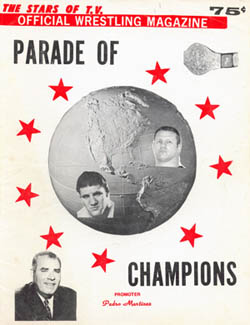
An NWF program from June 1972.
Q: You got quite a push from the NWF.
A: Yeah, because I drew his biggest houses. I guess that Hans Schmidt and myself drew his biggest house for him.
Q: .As the greatest heel to ever come out of wrestling, you’re often pitted against the Sammartinos, Dennuccis and the Strongbows of the ring. However, you’ve also had to face other fellow deviants such as Ray Stevens, King Curtis and especially Killer Kowalski – who you tag teamed with! With your famous tactics against equally opposing tactics and a crowd not sympathetic to one side, do you have any memories to share of these matches? [Bruce Metcalfe]
A: I don’t remember wrestling too many other (bad) guys, except Schmidt.
Q: I guess his question is, is it fun wrestling those type of matches, bad guys against bad guys?
A: I usually always ended up as the heel (chuckles), for some reason or another. They used to hate me more than they did them.
Q: What tactics would you …
A: My attitude as the heel, just put it that way.
Q: Have you or are you planning to donate your ring wears, such as boots, helmut, and crop to the Hall of Fame? [Bruce Metcalfe]
A: I haven’t donated anything.
Q: How much of that stuff do you still have?
A: I’ve got a uniform, I’ve got my boots.
Q: Do you still have the riding crop and the helmet?
A: Cripes, I’ve probably got it someplace. I don’t know. (laughs)
Q: So it’s they’re not at the front door, ready to wear!
A: No. I think I’ve got my boots packed away in a plastic bag, I’ve got my suits hanging up. I’ve got the first cape that I ever used. It was so funny. My wife said 29 inches, and my chest was 50. I put it on, and closed it up, there was no movement from side to side. I had a picture one time, the Star, they used to do a big feature all the time, they had a picture in there when I had my long, blond hair, monocle.
Q: Wasn’t that the one where you had another partner?
A: Yeah, Chris, the chiropractor. He passed away a few months ago.
Q: What year was that in the Star? I don’t think I’ve ever seen that one.
A: Oh God, that was before, that was when I was with Red Garner, I believe.
Q: So it would have been ’56, ’57, then.
A: Yeah, I guess so.
Q: I’m hoping someday to find video footage of a famous Waldo von Erich “interview rant” to the camera! Have you been able to retrieve any footage from your wrestling days and do you have any knowledge of what Vince McMahon Jr. has in his vaults? [Bruce Metcalfe]
A: A lot of the stuff, like Calgary used to have, Stu Hart, they had it on what they called a high-band tape. I don’t know if you know that. It was a high-band tape, made with silver, and it wouldn’t keep too long. Apparently, it wouldn’t be too long until they got rid of it. We’d do the tape. There might be some 8 mm tape that one of the Hart brothers, Stu Hart’s sons have, I think.
Q: They sold what they had to Vince, I think.
A: The 8 mm?
Q: I don’t know, what they had I guess.
A: There were a few tapes of me, apparently on Google. I’m not familiar with the Internet. … people have seen it on it.
Q: But you don’t have a lot of old stuff?
A: I don’t have anything at all.
Q: Has he ever thought of writing a book? [Bruce Metcalfe]
A: Hmm, I kind of did, but I didn’t want to get too many people in trouble.
Q: Waldo, you scared the living daylights out my siblings and I in the late 1960s. We couldn’t wait to do it all over again the next Saturday! Did you plan your promos in advance, or were they mostly off the cuff? [Mark from Port Hope]
A: Nope. I guess I was one of the best they ever had. (laughs) I don’t think I could do that now because I can’t remember what you said at the beginning of the line.
Q: So you’d be presented with who you were wrestling, and …
A: More or less ad lib.
Q: Whose idea was it for you to present Domenic Denucci, through Ron Martinez, with a package of spaghetti as a sympathy present for him supposedly cutting off his big toe with the lawnmower? [Mark from Port Hope]
A: God, I don’t remember. I remember a few different things.
Q: Does one interview stand out above the rest?
A: I can’t really say, no. I remember when I was down South, they were so damn funny. The guys, the camera crew, the guys, would be sitting there laughing, but when I got out there, they were so goddamn mad you could hear a pin drop. The wrestlers used to run behind the curtain, pissing themselves laughing.
Q: When you started out as Wally Sieber, do you remember working for Larry Kasaboski in Northern Ontario and do you recall any of the guys you worked with? [Gary Howard, Pembroke]
A: When they got me, when I was Wally Sieber, they were grooming me to take over [Whipper] Watson’ place, you know that?
Q: There were a lot of different Watson protégés over the years.
A: They only wanted 50% off me. I said no thank you. I’d won quite a few weightlifting; I’d held the 45-and-over world lifting record (??), you knew that. That was before steroids even. I was doing the bench with 495, pressing 295 sitting down, behind the neck, 750 in the squat. I’ve got a picture somewhere — I don’t know what the hell happened to it — of me lifting Haystack Calhoun up.
Q: Wow.
A: I don’t where the hell it is. He used to sit on you. One time he sat on me, I said, ‘Hang on,’ and I picked him up, and walked across the ring with him. I’ve got the picture someplace. I don’t know where the hell it is. I’ve been looking for it. He said, ‘Don’t do that again. It don’t look too good.’ He only weighed 600 pounds, or something like that.
Q: That’s a good example of where if he’d started to wiggle, you’d be in real trouble.
A: I remember Wes [Hutchins, Hartford of the Love Brothers], he would get on top of me, and I’d bench press him, throw him right up and over the top rope.
Q: From lying on the ground, on the mat?
A: Yeah. He said, ‘Holy Christ.’ You know, when you could bench press 500 pounds, 240 pounds is nothing. I used to do 30 reps of 350 to warm up with.
Q: Do you remember much about your time with Kasaboski in Northern Ontario?
A: It was just a really short thing there, it wasn’t very much.
Q: That would have been really early in your career.
A: That would have been the early part.
Q: Was there anyone there who really helped you learn the craft?
A: No, no, no. I learned everything pretty well down there from Red Garner. I used to work out down in Toronto with George Chuvalo, you know that.
Q: And all the Toronto guys there in the gym?
A: It wasn’t too many, mainly Dave McKigney. Well there was Mike Scicluna, Dave. That was pretty well the only guys that made the big time, if that’s what you want to call it.
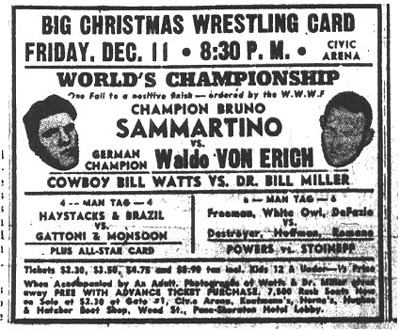
December 11, 1964 in Pittsburgh.
Q: My question for Mr. von Erich is, What was his toughest match? [Peter Stasko from Queens, NY]
A: My hour and 28-minute match with Bruno Sammartino.
Q: Was that the curfew match?
A: They used to always put the main event in the third match, because they had an 11 o’clock curfew. Well, we were sold out two weeks after they announced the match. They told people that, but we still turned away close to 20,000 people. At that time, $75,000 was a complete sell out.
Q: Was that match so tough because Bruno was so tough to work with, or because it went so long?
A: When I went in there, I thought it was just an hour match. I remember looking at the clock, thinking, ‘Holy crap, it’s nearly an hour and a half!’
Q: So the time flew by?
A: Yeah.
Q: Johnny Valentine, did you ever work with him in the ring? [Larry Dorfman]
A: I’m just trying to think, Johnny Valentine. I think I worked with him once or twice, but that’s it. It’s hard to say, I don’t remember.
Q: Did you get to know him at all? You would have been sharing a dressing room.
A: One time, I think it was him, I was laying down, and somebody gave me a hotfoot on my shoes. Well, I got even with him — I poured molasses all over his shoes, in his shoes, and everywhere. (chuckles)
Q: He was notorious for ribbing. Does anyone else stand out for being a big ribber that you had run-ins with?
A: No…
Q: Because you weren’t a big ribber, right?
A: I didn’t play ribs. I kibitzed around a lot, had fun with the guys. I enjoyed myself with the guys. They all liked me, liked being around me. I was never doing anything serious, anything that would cost them money or anything like that. I always helped the guys quite a bit.
Q: Some guys claim they work 300+ days a year. I’m curious as to your work schedule at the peak of your popularity. [Markus von Boltenstern, Ottawa]
A: I might work four times in one day!
Q: Would those have been weekend TV tapings?
A: For instance, in New York, they had an afternoon show, and they would always put the main event on early. I’d wrestle, and we wouldn’t even have time to shower, and we’d jump in a cab and drive someplace else. Let’s see, I’m just trying to think. In Minneapolis, we’d drive, I would end up in Denver, Colorado. I would have an afternoon TV show, and I’d work four times. Usually, two times on a Saturday, would be about it. Sometimes three times.
Q: So at your peak, you’d easily be working more than 300 dates a year?
A: Oh yeah. Yep.
Q: He also asks what kind of money you made. Any idea what your best year would have been? [Markus von Boltenstern, Ottawa]
A: I won’t disclose too much. The most I made back then, which was a lot of money, was around close to $4,000 for Madison Square Gardens. You got paid roughly 8% on the gate, which the promoter took out. You could buy a bloody Cadillac for that price.
Q: And Bruno would have made a little bit more?
A: I don’t know what his situation was with them. I know that it was supposed to be — now, whether it was or not, I don’t know, really.
Q: Will you go see Darren Aronofsky’s movie The Wrestler? [Markus von Boltenstern, Ottawa]
A: No, I haven’t bothered. I don’t know how much bullshit there is in it.
Q: It’s pretty good. I’ve seen it.
A: Oh, have you?
Q: It’s pretty accurate for the guys from the ’80s on, kind of thing.
A: That’s what I thought.
Q: You’d probably enjoy it, seeing a DVD down the road.
A: What’s different about it? What stands out about it?
Q: It’s just pretty accurate. As I was sitting there watching it — as you know, we were so close to Dewey [Robertson] because Meredith, my wife, wrote his book — so you’re watching it, he can’t let go of wrestling, he’s always got to be getting back in there, he’s gotten crummy jobs, ruined his life with his family and all this. It was just like watching a movie about Dewey Robertson. It was just like watching a movie about Lex Luger, or whomever it is. You see a lot of parallels with guys who went through bad times, who still stuck around the business and couldn’t give it up.
A: Okay, with me, I never had that problem. It was not my problem, or the other guys (from my era), because there wasn’t as many wrestlers around. After that, shit, you’ve got all these guys on the hardcore fighting and all of this. I don’t like it anymore, because there’s too much bullshit, too much blood and gore, and I think it’s bad for the kids, I really do. I really don’t like it.
Q: After Fred Blassie was taken away by police on a WWWF TV match, did Waldo have to bail him out, or was Fred just thrown out of the building? 😀 Seriously, who came up with that angle, as I’d never seen it before on WWWF TV. [David Read, Pennsylvania]
A: Fred was my manager?
Q: Yeah. Do you remember when he was taken away?
A: God, where was that, out of New York?
Q: Yeah, but it would probably have been taped in Allentown, or Poughkeepsie.
A: Well, Vince had a certain area, and Pedro had a certain area. Well, that was with Vince. I don’t remember. I’ve got a picture of Fred and I standing up in one of the halls, or something like that.
Q: What were his favourite memories of working with Bulldog Brower in Australia? [Don McSaltey]
A: He was a bit of an ass. (chuckles) He wasn’t the brightest, let’s put it that way. I remember one time I drove all the way from Toronto to Windsor, and he drove all the way in the passing lane, never once did he get out of the passing lane. (laughs) His daughter was as fat as he was. She was a little plump kid. … He got a call when he was in Australia, he got a call, his wife [had] packed up, left the house, and took all the furniture and stuff. He was banging his head against the wall. He was a bit of a wing-ding.
Q: So there was similarity between the Bulldog’s ring persona to the way he was away from the squared circle? [Don McSaltey]
A: Well, he might have gone a little farther if he had. I guess it’s hard to say. He wasn’t the brightest, let’s put it that way.
Q: This one goes back to the training you did. When you saw guys like The Highlanders, or whomever, was there something that you looked for in somebody to have potential to be a good wrestler? [Mike Wood, Kentucky]
A: You mean Derek and those guys?
Q: Yeah, Derek and Rory.
A: I just talked to them the other day, they called me up. …
Q: Was there something specific you looked for?
A: You could tell a person just by the way he got in the ring, the way he handled himself. It’s hard to say. Just looking at a person, by his actions, the way he moves around, you can tell whether he has anything, whether his qualifications are there.
Q: We’re jumping ahead to the World Class promotion now in the 1980s, down in Texas. Were you ever invited down to participate in any angles down there? [Courtney Marshall]
A: I was the one that got Fritz [von Erich] into that. If it wasn’t for me, he wouldn’t have gotten there. I was working for [Morris] Sigel and those guys out of Houston, and they had everything built around me, everything. There was Joe Blanchard, he started running these other towns. When I left Sigel, and went to Fritz, then it broke them up. I was supposed to get 25% of the territory. Fritz was a user too. He got into this here religion, what do you call it, Born-Again Christians, or something like that. He was a user too.
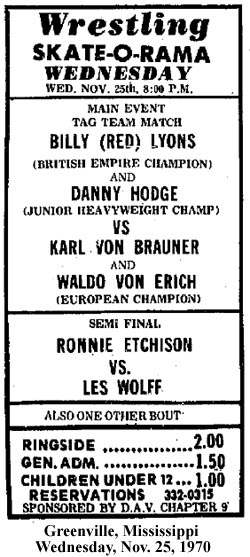
Q: At that point, you disassociated yourself with Fritz?
A: Well, what happened was, Leroy McGuirk, who had the Oklahoma territory, and Bill Watts bought into there. No one would go into there for him because they weren’t drawing anything. Bill kind of saved my ass one time down there in New York when we started to have a riot for beating Bruno, and they started to rip up the goddamn arena, and they had to reverse the decision. (chuckles) He was a babyface too, and he started fighting like hell when they threw me out of the ring and everybody was on top of me. I’ll never forget that. He asked me if I’d come out and work for him. That’s when I left Texas and I went out and worked for him, for Bill and Leroy.
Q: So you never had anything to do with Fritz after that? You never went back?
A: I never bothered because I had no use for him. I was just very disgusted with the guy, because I was supposed to get 25% … if it wasn’t for me, he wouldn’t have had anything.
Q: Years later, they brought in a guy they named Lance Von Erich, that they said was your son.
A: I heard about that.
Q: But you didn’t know anything about it?
A: I didn’t know anything about it. It had nothing to do with me.
Q: With his German persona, was he ever approached by Nazi sympathizers to do anything illegal, or even discuss the subject? [Dave Drason Burzynski, Detroit]
A: Oh yeah, in Australia. (laughs) These characters come up with these long, bloody overcoats on, wanting me to go in with them. They were fucking windings. Crewcuts and everything. They were real coo coos.
Q: So you just brushed them off?
A: Yeah, it was just stupid.
Q: Was there any of that in the U.S.?
A: No, nothing was ever approach to me in the U.S.
Q: What was it like working in Detroit for The Sheik? [Dave Drason Burzynski]
A: I didn’t do too much for Eddie. I was in and out. That was because Eddie built everything around himself.
Q: He didn’t need another competing heel.
A: He didn’t want no one competing, period.
Q: You maintained a friendship with him over the years?
A: Oh yeah, Ed was a likable guy, and all that. You can’t blame a guy for protecting his own interests. I talked to his wife here the other day.
Q: Where did the idea come from for the heel role as a Nazi? [John Perin, Cincinnati, Ohio]
A: I started out as Waldo von Erich, and I wore a monocle, just I didn’t walk around with a Nazi uniform. I only started that when I worked down there in New York, when I had Red Berry, walking around Broadway with my uniform on; I’m not sure I could do that now — I’d probably get shot. Either that, or the Arabs would want me on their side.
Q: So it was in New York that it really got ramped up?
A: Yeah, pretty well that’s it.
Q: Where would you have found some of the costume pieces?
A: I had them made up by a Jewish uniform outfitter! (laughs) Out of Pennsylvania, or one of those places. The guy made uniforms, and they had authentic crests and whatnot that he got from antique shops.
Q: They were genuine?
A: I had a couple of helmets. Some kid in Australia walked into the dressing room and stole one of them. I had my hat; I don’t know what the hell happened to it, I can’t find it anywhere. I’ve got an older one, but it’s not too old. I don’t know where the hell it is. I think I lent it to somebody.
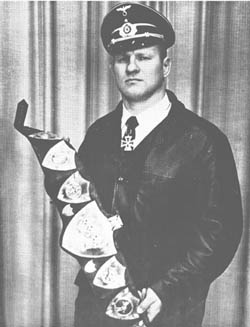
European champion
Q: Living in Melbourne, Australia I have very fond memories of Waldo von Erich given that he was a regular visitor to our shores in the late ’60s and early ’70s. Waldo was a mainstay in the long running feud between The People’s Army (consisting of King Curtis, Mark Lewin, Spiros Arion and Mario Milano) and Big Bad John’s Army (consisting of Waldo, Tiger Jeet Singh, Abdullah the Butcher, Bulldog Brower, Tojo Yamamoto and Killer Karl Kox amongst others). This feud was lengthy, bloody and packed out arenas Australia wide. Wrestling was the “hottest ticket in town” every Saturday night at Festival Hall. Do you have any memories of that feud and recollections of his time Down Under. [David Tepper, Melbourne, Australia]
A: Well, I was the one that more or less made Australia. I know that when I worked for [Jim] Barnett, I went over and wanted to go home. I went over for three months, a shot, you know, and I more or less made the territory. I wanted to go home for two weeks, but I had to turn around and go back the next day because the territory just went pfffft, just dropped right down to nothing. See, a lot of the thing, Mark Lewin, being Jewish and all, Barnett kind of took his advice, which was a lot stupid things. I was doing all the drawing, you follow me? People came to see me get beat. But Mark had persuaded Jim to let him beat me, or something like that, and that’s what happened.
Q: Doesn’t that sort of happen everywhere, where somebody gets in the promoter’s ear?
A: You’re absolutely right. The same thing, when I started out down there for Ted Turner, he bought in. I had so much heat down there he was sure he was going to lose the television channel, so Jim Barnett let me go. It was a stupid thing. They should have let me take over and run the goddamn show for them. Stupid, because Ted had more money and more places and television channels than Vince McMahon did.
Q: He was the pioneer of cable.
A: He got these other guys in there, and I guess they bent his ear, and he listened, and that’s when he started losing out to Vince, which was a stupid, bloody thing, because you never let a guy that’s wrestling run the goddamn show because they’re always going to put things over for themselves. Stupid. You never have that. That’s the worst thing you can do.
Q: What were the Australian arenas like? [Pete Jarvis, Hamilton, ON]
A: Ahhh.
Q: Were the crowds different?
A: They all hated me. I can’t say anything. No, I can’t say they were different. They all hated the German.
Q: Do you have any memories of Big Bad John? [Pete Jarvis, Hamilton, ON]
A: Well, I guess if it wasn’t for me, they wouldn’t have had a Big Bad John, they wouldn’t have had the People’s Army.
Q: Was he a decent guy to get along with?
A: I didn’t have any problem with him. It was just business.
RELATED LINKS
- July 13, 2009: A final goodbye to Waldo von Erich
- July 7, 2009: Waldo von Erich: The consummate heel
- July 6, 2009: Waldo von Erich dies suddenly
- July 6, 2009: The fans share Waldo von Erich memories
- March 18, 2009: Waldo von Erich Q&A: Part 2
